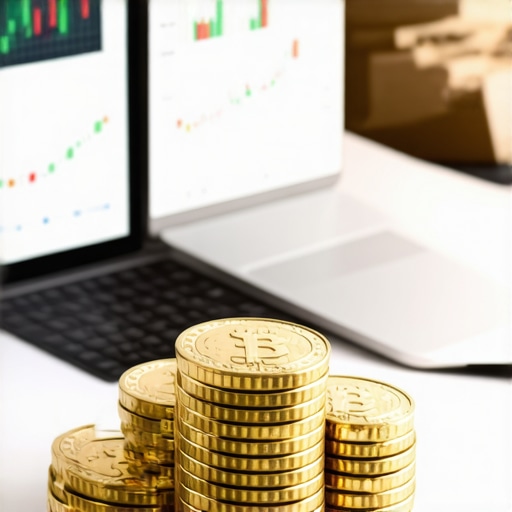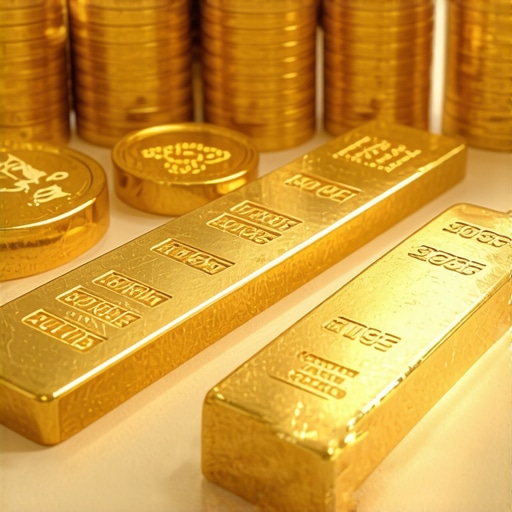My First Encounter with Physical Gold: Coins vs. Bars
When I first decided to invest in gold, I was overwhelmed by the variety of options available. I vividly remember holding a shiny gold coin for the first time—its intricate design and tangible value felt exciting. However, I soon learned that gold bars offered a different kind of appeal: they were more cost-effective when buying larger quantities, though less flashy than coins.
Investing in physical gold like coins and bars gave me a hands-on sense of security. There’s something reassuring about holding your investment in your hands, especially during uncertain economic times. Yet, storage and authenticity verification became immediate concerns I had to address.
Why I Consider ETFs For Diversification
As my portfolio grew, I explored gold ETFs (Exchange-Traded Funds) to complement my physical holdings. ETFs offered me liquidity and diversification without the hassle of physical storage. They track gold prices closely, allowing me to benefit from market movements with ease.
While ETFs lack the tactile satisfaction of coins or bars, they provide a practical alternative for investors like me who want exposure to gold without the complexities of handling physical assets. For those curious, this beginner’s guide to gold ETFs helped me understand the nuances behind these investments.
How Do You Decide Between Physical Gold and Gold ETFs?
This is a question I often ask myself and fellow investors. The answer depends on your goals: are you seeking a tangible asset for long-term security, or do you prefer market flexibility and ease of trading? For me, balancing both has been key. Physical gold coins and bars serve as a hedge against inflation and currency risks, while ETFs offer quick entry and exit when market conditions demand agility.
Additionally, I found that educating myself on gold demand trends and price forecasts, such as insights from trusted market analyses, enhanced my confidence in making informed decisions.
If you’ve had experiences with any form of gold investment, I’d love to hear your thoughts and stories. Feel free to share in the comments below—your insights could help others navigating this fascinating market.
Incorporating Gold Mining Stocks Into Your Portfolio
While physical gold and ETFs serve distinct roles in an investment strategy, I found that adding gold mining stocks can introduce a compelling growth dimension. Unlike owning physical gold or ETFs that mirror gold prices, mining stocks are influenced by company-specific factors such as operational efficiency, management decisions, and geopolitical risks in mining regions.
These stocks offer leveraged exposure to gold prices, meaning that when gold prices rise, mining stocks can potentially increase at a higher rate. However, this comes with increased volatility and risk. For investors comfortable with market fluctuations, integrating top-performing gold mining stocks can diversify risk and enhance returns.
For a practical starting point, I explored a detailed analysis of gold mining stocks for 2029, which helped me identify companies with strong fundamentals and promising growth outlooks.
How Does Central Bank Gold Purchasing Influence Market Dynamics?
Central banks play a pivotal role in shaping the gold market. Their purchasing patterns can signal confidence in gold as a reserve asset and influence global supply dynamics. For instance, when central banks increase their gold reserves, it often supports price stability or upward movement by reducing available supply.
Understanding these movements has been crucial in timing my trades and anticipating market shifts. Central bank buying can also reflect broader economic policy trends, such as hedging against currency devaluation or geopolitical uncertainties.
To deepen your understanding, I recommend reviewing insights on central bank gold purchases and their impact on price movements, which provide authoritative analysis backed by recent data.
What Are the Key Risks When Combining Physical Gold, ETFs, and Mining Stocks?
From an expert perspective, blending these asset types requires diligent risk assessment. Physical gold offers security but faces liquidity and storage challenges. ETFs provide liquidity but are subject to market risks and management fees. Mining stocks introduce operational and market volatility risks.
Balancing these involves considering your investment horizon, risk tolerance, and market outlook. For example, during economic uncertainty, physical gold may safeguard wealth, while ETFs and mining stocks could offer growth during bullish phases. Diversification across these forms can hedge against individual asset class weaknesses.
Moreover, staying informed about global economic indicators, geopolitical events, and gold demand trends — as discussed in trusted market analyses — strengthens your ability to optimize portfolio allocation effectively.
If you have experiences or questions about integrating different gold investments, please share your perspectives in the comments. Collaborative insights help build a more nuanced understanding for all investors.
Reflecting on the Emotional and Strategic Dimensions of Gold Investing
Gold has always fascinated me not just as a commodity, but as a psychological anchor in my investment journey. Beyond the numbers and market trends, holding physical gold invokes a sense of permanence and tangible security that digital assets often can’t replicate. Yet, as I delved deeper, I realized that investing in gold isn’t just about possession but about understanding its multifaceted role in a portfolio.
For instance, I’ve come to appreciate how gold’s behavior during market volatility differs from other assets. While stocks might plunge amid uncertainty, gold often acts as a safe haven, preserving purchasing power. This protective characteristic has shaped my strategic allocation, especially in times when economic indicators signal instability. However, this isn’t a one-size-fits-all approach; each investor’s risk tolerance and goals play a crucial role.
Balancing Patience and Agility: Lessons From Trading Gold Futures and ETFs
My experience with gold ETFs and futures introduced me to a dynamic side of gold investing where timing and market insight matter profoundly. Trading gold futures, for example, requires an understanding of leverage, margin requirements, and market sentiment—skills I sharpened through trial, error, and extensive reading like this beginner’s guide to trading gold futures.
Gold ETFs, on the other hand, have allowed me to maintain portfolio liquidity while staying exposed to gold price movements. The challenge here has been to balance the immediacy of trading with the long-term preservation goals I have with my physical gold holdings. It’s a nuanced dance between patience and agility that has evolved over time.
How Do You Navigate the Psychological Challenges of Gold Market Volatility?
This question often surfaces among my peers and in community discussions. Volatility in gold prices, influenced by geopolitical events, central bank activities, or changing demand trends, can trigger emotional responses ranging from fear to greed. I’ve learned that cultivating a disciplined mindset—grounded in thorough research and clear investment objectives—helps me resist impulsive decisions.
Moreover, understanding the underlying factors driving price swings, such as those outlined in trusted market analyses on gold demand trends, equips me with context that tempers knee-jerk reactions. This perspective has been invaluable in maintaining composure and seizing opportunities rather than succumbing to anxiety.
Personal Reflections on Diversifying Within the Gold Ecosystem
While physical gold remains my foundation, incorporating ETFs and mining stocks has enriched my portfolio’s texture. Each form of investment offers distinct risk-return profiles, and juggling them requires constant reassessment. For example, mining stocks bring growth potential but add corporate and geopolitical risk layers, whereas ETFs provide ease and liquidity but can detach from the tangible essence of gold.
Choosing the right mix has been less about chasing the highest returns and more about aligning with my evolving financial goals and market outlook. This journey has driven me to explore advanced resources, including the latest techniques for gold trading, which have sharpened my tactical decisions and risk management.
I’m curious—how have your experiences with various forms of gold investment shaped your approach? Have you found certain strategies or insights that fundamentally changed your perspective? Please share your stories or questions in the comments below; these conversations often reveal unexpected wisdom and foster a supportive community of like-minded investors.
Unveiling the Intricacies of Gold Price Forecasting and Market Sentiment
Delving deeper into gold investing inevitably brings me face-to-face with the art and science of price forecasting. Unlike many commodities, gold’s price movements are shaped by a complex interplay of macroeconomic indicators, geopolitical tensions, and supply-demand dynamics. Over the years, I’ve studied various forecasting models, learning to interpret signals such as inflation rates, real yields, and currency fluctuations to anticipate price swings more accurately. However, the real mastery lies in blending quantitative data with qualitative market sentiment—a nuanced skill that transcends textbook analysis.
For those eager to sharpen their forecasting acumen, I found the gold price forecast for 2029 resource particularly enlightening. It dissects key drivers behind price fluctuations, underscoring how central bank policies and global economic shifts set the tone for gold’s trajectory. Integrating these insights into my trading strategy has enhanced my ability to pivot timely, balancing patience with tactical agility.
How Can Advanced Trading Techniques Mitigate Risks in Volatile Gold Markets?
When I transitioned from passive holding to active trading, I realized that volatility—while daunting—offers fertile ground for profit if approached with discipline and sophisticated tools. Techniques such as stop-loss orders, options hedging, and algorithmic trading have become part of my arsenal. Implementing these strategies requires not only technical know-how but also psychological fortitude to adhere to predefined risk parameters, especially during market turbulence.
One advanced approach I’ve refined involves layering trades across different instruments—combining physical gold, ETFs, and futures—to optimize exposure and manage downside. This hybrid tactic leverages the stability of physical assets while exploiting the liquidity and leverage opportunities present in derivatives. For a comprehensive dive into these methods, this guide on advanced gold trading techniques has been instrumental in elevating my strategic framework.
Navigating the Psychological Labyrinth of Gold Investing: Beyond Rational Analysis
Investing in gold is as much an emotional journey as it is a strategic one. Over time, I’ve come to appreciate how psychological biases—such as loss aversion and herd mentality—can cloud judgment and lead to suboptimal decisions. For example, during spikes in gold prices driven by geopolitical crises, I’ve witnessed seasoned investors succumb to FOMO (fear of missing out), only to face swift corrections.
To combat these pitfalls, cultivating emotional intelligence and mindfulness has been key. I practice reflective journaling of trades and market reactions, which helps me identify recurring behavioral patterns. Moreover, engaging with a community of informed investors provides a sounding board to challenge my assumptions and reinforce a rational perspective. Resources like expert strategies for securing physical gold wealth have also guided me in aligning my psychological stance with robust investment principles.
What Role Does Emotional Discipline Play in Long-Term Gold Portfolio Success?
From my experience, emotional discipline is the linchpin that undergirds sustainable success in gold investing. It enables me to withstand market noise, adhere to a well-defined investment thesis, and avoid impulsive trades driven by short-term fluctuations. This trait has been especially critical when integrating volatile assets like gold mining stocks alongside stable physical holdings and ETFs.
Ultimately, cultivating such discipline is an ongoing process—one that involves continuous education, self-awareness, and strategic patience. If you’re interested in exploring how emotional resilience intersects with tactical gold investment, I invite you to share your experiences or questions. Together, we can deepen our understanding and refine our collective approach to navigating the multifaceted gold market.
Things I Wish I Knew Earlier (or You Might Find Surprising)
The Emotional Weight of Physical Gold
Holding a gold coin or bar isn’t just about the asset’s value—it’s about the emotional reassurance it brings. Early on, I underestimated how much that tangible connection would affect my confidence during volatile markets. It’s a unique psychological anchor that digital or paper investments often can’t replicate.
Liquidity Is a Double-Edged Sword
While ETFs and futures provide flexibility to enter and exit positions quickly, I learned the hard way that this liquidity can tempt impulsive trades. Balancing patience with agility became a critical skill, especially when market noise tries to push decisions based on short-term swings rather than long-term strategy.
Mining Stocks Are Not Just Gold Proxies
I initially treated gold mining stocks as just another way to gain gold exposure, but their corporate and geopolitical risks add complexity. Recognizing that they often behave differently from physical gold or ETFs helped me diversify more wisely and avoid surprises during turbulent periods.
Central Bank Moves Matter More Than You Might Think
Understanding how central bank gold purchases influence supply and sentiment gave me an edge in anticipating price shifts. These purchases often indicate broader economic trends and can stabilize or disrupt the market in ways that aren’t immediately obvious without deeper analysis.
Psychological Discipline Beats Market Timing
Attempting to time gold price highs and lows felt like chasing shadows until I focused on developing emotional discipline. This mental framework has been invaluable, especially when integrating volatile assets like mining stocks alongside steady physical gold and ETFs.
Resources I’ve Come to Trust Over Time
BuyingGoldNow.com has been a consistent companion on my journey, especially their expert strategies for securing physical gold wealth which offered practical advice on storage and authenticity.
The guide to gold ETFs helped me grasp the nuances of these instruments and balance my portfolio effectively.
For understanding market drivers, the gold demand trends analysis provided insightful data that sharpened my forecasting skills.
When I ventured into trading futures, this beginner’s guide was indispensable for building foundational knowledge and avoiding common pitfalls.
Lastly, the advanced trading techniques resource refined my approach to risk management and tactical positioning during volatile phases.
Parting Thoughts from My Perspective
Investing in gold has been a multifaceted experience—one that blends tangible security with strategic agility and emotional resilience. Whether it’s the reassuring heft of physical gold bars or the nimble accessibility of ETFs, each form plays a distinct role in my portfolio’s health. The main takeaway? Diversification within the gold ecosystem isn’t just about spreading risk; it’s about embracing gold’s complex nature as both a safe haven and a dynamic investment.
For anyone stepping into this world, I encourage you to blend education with introspection. Understand the market forces, but also recognize your own psychology. If this resonated with you, I’d love to hear your thoughts or experiences. Feel free to share your stories in the comments below—our collective insights make us all stronger investors.











Reading about the initial allure of physical gold, especially coins versus bars, really resonated with me. I remember my first physical gold purchase—holding that shiny coin gave me a tangible sense of security, much like the author described. Since then, I’ve also explored gold ETFs for liquidity and ease of trading, which has been a game-changer during volatile markets. My experience shows that blending physical gold with ETFs can balance security and flexibility effectively.
The mention of gold mining stocks adds another layer of complexity. I’ve found that these stocks are impacted not just by gold prices but also by company-specific factors, which can create opportunities or risks. Have others found particular mining companies more resilient during downturns?
Considering central bank activities, I wonder how current geopolitical tensions are influencing their gold reserves. Do you think central banks will continue to buy aggressively, or could we face periods of selling in the near future? It would be interesting to hear others’ insights on how global monetary policies are shaping gold investments today.